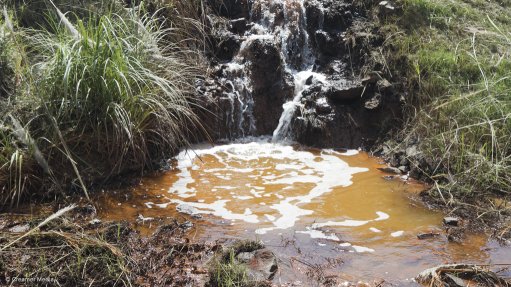
PROBLEM POINTS
There is a need to define hydrologic connectivity between surface and groundwater and mine workings to understand the source of water and contaminants at decanting points
Photo by: Duane Daws
Surface and groundwater qualities in some areas of South Africa continue to be degraded by acid mine drainage (AMD), warns Council for Geoscience (CGS) environmental geo- scientist Thato Kgari.
Most abandoned mines consist of complex multiple-level workings connected to a drainage tunnel discharging AMD into lower-lying regions. Kgari explains that discharging mine water poses grave problems for the receiving environment.
Therefore, she says there is a need to define hydrologic connectivity between surface and groundwater and mine workings to understand the source of water and the contaminants at the decanting points.
Kgari notes that limited studies have been done in South Africa into the feasibility of using hydrological tracer techniques to determine mine water sources, parti- cularly in understanding underground water dynamics.
“Locally, there are no regulations and/or standard procedures for such activities. In some countries, such as Germany, there are regulations that govern the use of tracers,” she points out.
Kgari explains that commonly used tracer substances include dye, salt and stable isotopes. These substances can be carried in solution with the aim of characterising the subsurface to estimate water flow and storage properties.
“These are vital aspects in mine source determination, mine water management, treatment and remediation,” she emphasises.
Moreover, Kgari points out tracers provide an indirect method for characterising aquifers that are suitable for use in steady-state and transient flow conditions.
She remarks that eight water samples have been collected by the CGS from different discharge points in and around a flooded and abandoned coal mine in the eMalahleni coalfields, in Mpumalanga.
“This was done to classify the different water types as a preassessment for using tracer techniques. Our preliminary ion chromatography and inductively coupled plasma mass spectrometry results demonstrated that the water samples collected had high concentrations of major cations and anions, such as sulphate, chlorine, sodium, magnesium, aluminium, potassium, calcium and vanadium,” highlights Kgari.
She says that, given that different types of tracers are compatible with different hydro- geological environments, these water geochemistry results will be important in identifying the types of tracers that will be best suited to further study the area.
“Tracer techniques have a broad application in science and have demonstrated a particular usefulness in hydrogeology,” Kgari concludes.